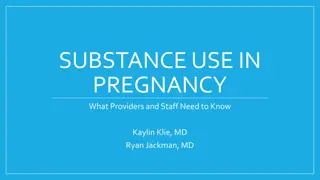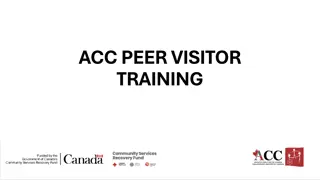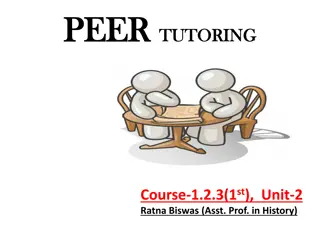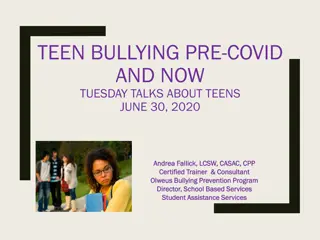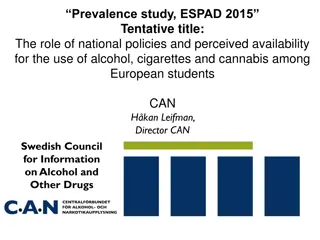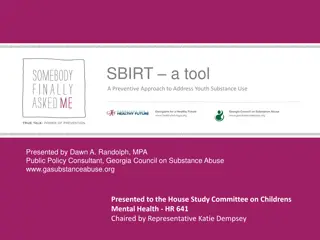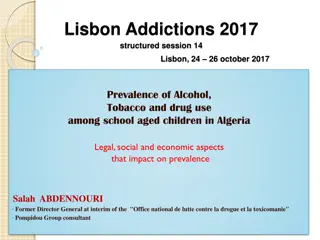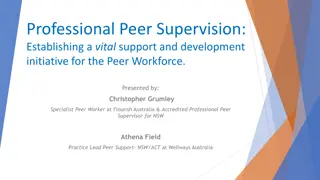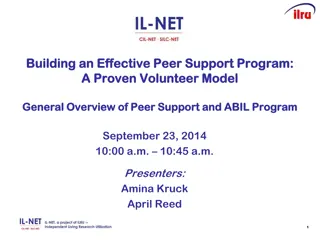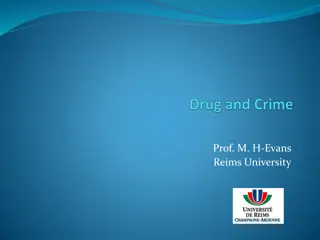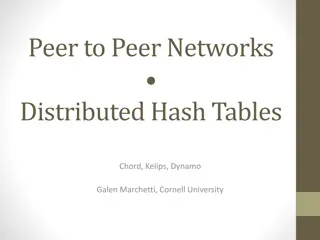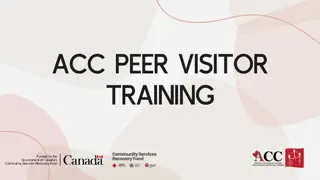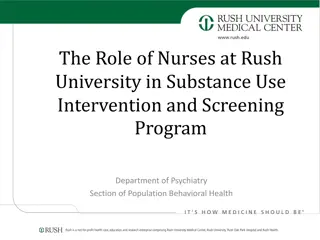Associations Between Substance Use and Peer Influence Among German University Students
This study explores the associations between personal substance use, perceived peer use, and attitudes towards substance use among German university students. It focuses on social norms interventions and the adaptation of personal behavior based on perceived peer behavior. The study aims to assess substance consumption frequencies, perceptions of peer use, and gender-specific social norms feedback among university students in Germany.
Download Presentation

Please find below an Image/Link to download the presentation.
The content on the website is provided AS IS for your information and personal use only. It may not be sold, licensed, or shared on other websites without obtaining consent from the author.If you encounter any issues during the download, it is possible that the publisher has removed the file from their server.
You are allowed to download the files provided on this website for personal or commercial use, subject to the condition that they are used lawfully. All files are the property of their respective owners.
The content on the website is provided AS IS for your information and personal use only. It may not be sold, licensed, or shared on other websites without obtaining consent from the author.
E N D
Presentation Transcript
1 ASSOCIATIONS BETWEEN PERSONAL AND PERCEIVED PEER USE AND ATTITUDES TOWARDS SUBSTANCE USE AMONG GERMAN UNIVERSITY STUDENTS FINDINGS OF A MULTI-CENTRE CLUSTER-CONTROLLED INTERVENTION TRIAL S.M. Helmer, C.R. Pischke, S. Schneider, R. Reintjes, A. Schmidt-Pokrzywniak, M. Girbig, A. Kr mer, A. Icks, U. Walter, H. Zeeb Lisbon Addictions 2017
Background: Social Norms Interventions 3 Adaptation of personal behaviour to perceived behaviour Perceived peer behaviour
Background: Social Norms Interventions 4 Adaptation of personal behaviour to perceived behaviour Perceived peer behaviour Adaptation of personal behaviour to perceived behavior Misperception of peer behaviour
Background: Social Norms Interventions 5 Adaptation of personal behaviour to actual Adaptation of personal behaviour to perceived behavior behavior Misperception of peer behaviour
6 OBJECTIVES To assess self-reported frequency and approval of the consumption of licit and illicit substances among university students in Germany and measure perceptions of peer use and approval Development, implementation and evaluation of a web- based gender-specific personalized social norms feedback Target population: university students (all semesters, all subjects), eight German universities
Sample characteristics 7 HAW Hamburg (n = 573) MHH Hannover (n = 106) University Bielefeld (n = 525) University D sseldorf (n = 334) University Mannheim (n = 329) University Heidelberg (n = 627) TU MLU Halle (n = 714) Dresden (n = 1,361) in % Gender Female Male other Age Categories <20 21-25 26-30 31+ years 51.7 47.6 0.7 64.2 34.9 0.9 66.3 33.7 - 62.3 37.7 - 56.2 43.8 - 58.4 41.5 0.2 53.6 46.1 0.4 65.7 34.3 - 11.2 54.9 26.6 7.3 21.7 53.8 17.9 6.6 18.5 49.9 24.2 7.4 29.9 41.7 19.7 8.7 35.0 54.1 10.3 0.6 23.1 59.2 15.0 2.7 20.0 57.5 18.1 4.4 19.9 56.0 19.9 4.2 Residence (% living with other students) Field of study Arts Business and Law Engineering Medicine/ Health Sports Science Media Sciences Natural Sciences Social and Edu- cational Sciences Maths and Informatics 33.5 39.7 31.2 19.3 49.4 47.3 46.3 42.5 2.1 6.5 41.4 20.4 5.1 6.4 11.2 27.0 - - - 10.4 11.6 0.8 14.1 2.4 1.0 14.5 39.7 17.8 11.6 - 25.1 - 3.6 22.1 12.9 16.9 32.5 0.3 0.7 - 4.6 - 35.8 16.7 6.7 0.2 20.2 1.1 - 29.1 18.8 5.4 8.9 31.2 10.5 0.1 2.5 13.2 22.9 11.0 16.9 0.5 19.7 0.9 1.1 20.0 27.0 93.3 - - 6.7 - 6.9 - 5.5 6.9 9.3 7.1 5.3 2.9
Alcohol use 8 Never/not in the last two months Once in the last two months-Less than weekly Once or twice a week Thrice times a week HAW Hamburg MHH Hannover 9.4% 41.1% 32.2% 17.3% 11.3% 49.1% 27.4% 12.2% 13.0% 44.4% 32.6% 10.1% Uni Bielefeld Uni D sseldorf 13.2% 45.3% 32.3% 9.3% 11.0% 41.4% 31.6% 16.0% Uni Halle 10.3% 30.6% 33.4% 25.7% Uni Dresden Uni Mannheim Uni Heidelberg 4.8% 36.2% 40.1% 18.8% 13.2% 41.7% 31.1% 14.1% n=4,562
Cannabis use 9 in the last two months 25% 20% 15% 10% 5% 0% HAW Hamburg MHH Hannover Uni Uni Uni Halle Uni Uni Uni Bielefeld D sseldorf Dresden Mannheim Heidelberg n=4,560
Perceived peer vs. personal alcohol use 10 Self-other-discrepancies Students rated the peer use as higher than their own use Alcohol: 63% of female and 55% of male students viewed the average number of consumed alcoholic drinks at a single occasion as higher than their personal use 74% of female and 61% of male students thought that their peers show a higher maximum use at a single drinking occasion Cannabis: 46% of students thought that the majority of their peers used cannabis more frequently than themselves
Perceived peer and personal substance use 11 Perceptions of peers behavior were associated with corresponding personal use Average number of alcoholic drinks Students who perceived others to drink more alcohol were more likely to drink in average more than the majority of students ORFemale: 1.64 (95% CI: 1.55-1.75) ORMale: 1.72 (95% CI: 1.61-1.83) Cannabis use: Perception that majority of peers used cannabis at least once in their life: OR 1.63 (95% CI: 1.52-1.74)
Conclusion 12 German students show self-other discrepancies regarding the alcohol and cannabis use of their same sex peers Perceived norms significantly predict personal alcohol and cannabis consumption
Conclusion 15 German students show self-other discrepancies regarding the alcohol and cannabis use of their same sex peers Perceived norms are significantly associated with personal alcohol and cannabis consumption OUTLOOK: INSIST suggests beneficial effects of a social norms feedback on alcohol and cannabis consumption (but not on tobacco use) Subsequent DIOS-project: Development of stakeholder networks in favor of implementing and maintaining web-based social norms interventions at more universities also presented here at LX Addiction
Thank you for your attention! www.bips.uni-bremen.de Contact Dr. Stefanie Helmer Leibniz Institute for Prevention Research and Epidemiology BIPS Achterstra e 30 D-28359 Bremen helmer@leibniz-bips.de
Intervention Efficacy Changes in Frequency of Cannabis Use 17 Control Intervention Frequency of Consumption Not in the last 2 months Not in the last 2 months At least 1x/week At least 1x/week 1-4x/month 1-4x/month T1 T0 Not in the last 2 months 94.4% 5.3% 0.3% 95.7% 4.3% 0.0% 1-4x/month 32.2% 54.2% 13.6% 45.3% 47.2% 7.5% At least 1x/week 0.0% 22.5% 77.5% 14.3% 14.3% 71.4% Strong increase in consumption Increased consumption Stable consumption Reduced consumption Strong reduction in consumption
Cannabis Use Past Two Months 18 In the last two months Water pipe (4,541) Cannabis (n=4,560) Academic performance enhancing drugs (e.g. Ritalin) (n=4,565) Sedatives/ Sleeping pills (n=4,566) Synthetic cannabis (4,563) 8.4% 23.3% 1.7% 1.6% 1.1% HAW Hamburg 6.6% 6.6% 0.9% 0.0% 0.9% MHH Hannover 4.8% 17.3% 0.4% 1.7% 1.3% Uni Bielefeld 7.2% 19.8% 1.2% 1.2% 0.9% Uni D sseldorf 16.8% 23.1% 2.4% 2.4% 1.8% Uni Mannheim 11.2% 16.7% 0.7% 1.2% 0.4% Uni Heidelberg 15.2% 22.6% 0.7% 0.9% 1.1% Uni Dresden 9.6% 18.7% 1.0% 1.0% 1.0% Uni Halle
19 60 50 40 Appr oval of NMU PM 30 in % 20 10 0 Majority of their same-sex peers < own Majority of their same-sex peers = own Majority of their same-sex peers > own
Intervention efficacy 20 Results of the multilevel analysis Students at invervention universities compared to those at control universities have a 1.37 (95% Confidence limits=1.04-.,82) increased chance of not increasing cannabis consumption Relative to control universities, normative feedback was associated with higher odds for not increasing cannabis consumption (AOR: 1.37, 95% CI: 1.04-1.82) between baseline and follow-up.
Recruitment of students 21 Recrutiment of students at the different German universities Channels Personal recruitment: - Lectures/Seminars - Campus Universities Media: - E-Mail distribution lists - E-Learning-Plattform - Campusradio / Campusmagazine Students council: - i.e. Students union executive committee Campus: - Flyer - Poster Social media: - Facebook
Intervention Efficacy Changes in Frequency of Cannabis Use 22 Control Intervention Frequency of Consumption Not in the last 2 months Not in the last 2 months At least 1x/week At least 1x/week 1-4x/month 1-4x/month T1 T0 Not in the last 2 months 94.4% 5.3% 0.3% 95.7% 4.3% 0.0% 1-4x/month 32.2% 54.2% 13.6% 45.3% 47.2% 7.5% At least 1x/week 0.0% 22.5% 77.5% 14.3% 14.3% 71.4% Strong increase in consumption Increased consumption Stable consumption Reduced consumption Strong reduction in consumption
Background I 23 Intervention: Information about actual substance use Adaptation of personal behaviour to perceptions of substance use behaviour of peers Chance of perception and adjustment of personal behaviour Personal substance use (Mis-)perception of peer consumption
Changes in average Frequency of Cannabis Use from Baseline to Follow-up 24 0.2 0.1 0 -0.1 -0.2 -0.3 -0.4 -0.5 -0.6 MH Hannover HAW Hamburg Universit t Mannheim Universit t Heidelberg Universit t Bielefeld Universit t D sseldorf MLU Halle-Wittenberg TU Dresden Intervention Kontrollhochschulen
Perceived peer and personal cannabis use 25 viewed the average number of consumed alcoholic drinks at a single occasion as higher than their personal use 74% of female and 61% of male students thought that their peers show a higher maximum use at a single drinking occasion Majority of students rated the number of alcoholic drinks of their peers as higher than their own use
Design 26 Recruitment of participants/ Web-based baseline survey Wintersemester 2013/2014 Web-based intervention for intervention group Spring 2014 Follow-up assessment (intervention and control groups) Sommersemester 2014 Delayed intervention control group September/October 2014 Providing website including results and recommendations Beginning of 2015



